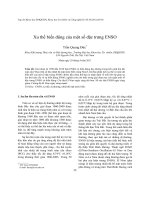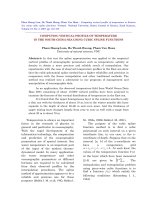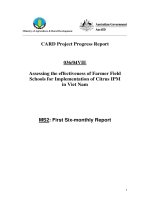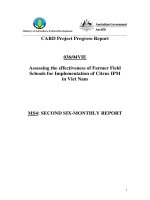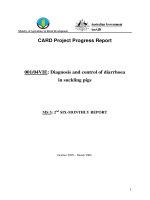Báo cáo nghiên cứu khoa học: " ON THE EXISTENCE OF SOLUTIONS OF NONLINEAR ELLIPTIC EQUATIONS WITH UNBOUNDED COEFFICIENTS" ppt
Bạn đang xem bản rút gọn của tài liệu. Xem và tải ngay bản đầy đủ của tài liệu tại đây (339.33 KB, 9 trang )
TẠP CHÍ PHÁT TRIỂN KH&CN, TẬP 9, SỐ 9 -2006
Trang 17
ON THE EXISTENCE OF SOLUTIONS OF NONLINEAR ELLIPTIC
EQUATIONS WITH UNBOUNDED COEFFICIENTS
Bui Boi Minh Anh
(1)
, Nguyen Minh Quan
(1)
, Tran Tuan Anh
(2)
, Vo Dang Khoa
(3)
(1) State University of New York at Buffalo, USA
(2) Georgia Institute of Technology, Atlanta, Georgia, USA
(3) University of Medicine and Pharmacy, Hochiminh City, Vietnam
(Manuscript Received on March 20
th
, 2006, Manuscript Revised October 2
nd
, 2006)
ABSTRACT : Using the topological degree of class
(
)
S
+
introduced by F. E.
Browder in
[
]
1
and
[
]
2
, we extend some results of the papers
[
]
3
and
[
]
4
to the case of
Banach spaces with locally bounded conditions.
1. INTRODUCTION
Let N be an integer 2≥ and D be a bounded open subset in
N
R . In this paper we
study the following equation:
() () ()()
NN
ii0
i1 i1
ii
u
a x, u g x,u g x,u a x 0 x D,
xx
==
⎡⎤
∂∂
∇− + + = ∀∈
⎢⎥
∂∂
⎣⎦
∑∑
(1.1)
The
p −
Laplace equation
(
)
p
ufx,u 0
−
Δ+ =
is a special case of
(
)
1.1
. If
p2
=
and
()
i
i
u
ax,u
x
∂
∇=
∂
then
()
1.1 has the form:
() ()()
N
i0
i1
i
u
u g x,u g x,u a x 0
x
=
⎡⎤
∂
−Δ + + + =
⎢⎥
∂
⎣⎦
∑
. (1.2)
The problem
()
1.2 has been solved in
[
]
4 (Theorem 3.1, p.514) by using the
topological degree for operators of class
(
)
B
+
. However, that method doesn’t work when
p2≠ and
()
p2
i
i
u
ax,u u
x
−
∂
∇=∇
∂
. The one we use here can solve the problem
()
1.2
for all
p1> .
Moreover, our result is also stronger than Theorem 11 in
[
]
3
(p.357) where the authors
prove the existence result for the Dirichlet problem:
(
)
p
D
ufx,u
u0
∂
−Δ =⎧
⎪
⎨
=
⎪
⎩
in
D
.
with the condition
(
)
10 that the function
b
is in
(
)
p
LD but not in
()
p
loc
LD.
2. TOPOLOGICAL DEGREE OF CLASS
(
)
S
+
In this section, we recall the class
(
)
S
+
introduced by Browder (see
[
]
1
,
[
]
2
).
Definition 2.1. Let
D
be a bounded open set of a reflexive Banach space
X
and
f
be
a mapping from
D into the dual space
*
X of X . We say f is of class
()
S
+
if f has the
following properties:
Science & Technology Development, Vol 9, No.9- 2006
Trang 18
(
)
i
(
)
{
}
n
n
fx
converges weakly to
(
)
fx if
{
}
n
n
x converges strongly to
x
in
D
, i.e.
f
is a
demicontinuous mapping on
D .
(
)
ii
{
}
n
n
x
converges strongly to
x
if
{
}
n
n
x
converges weakly to
x
in
D
and
(
)
nnn
lim sup f x , x x 0
→∞
−
≤
.
Definition 2.1. Let
{
}
t
g:0 t 1
≤
≤ be a one-parameter family of maps of
D
into
*
X .
We say
{
}
t
g:0 t 1≤≤ is a homotopy of class
(
)
S
+
, if the sequences
{
}
n
n
x and
(
)
{
}
n
tn
n
gx
converge strongly to
x
and
(
)
t
gx
respectively for any sequence
{
}
n
n
x
in
D
converging
weakly to some
x
in
X
and for any sequence
{
}
n
n
t in
[
]
0,1 converging to t such that
(
)
n
ntnn
lim sup g x , x x 0
→∞
−≤.
Let
f
be a mapping of class
(
)
S
+
on
D
and let
p
be in
()
*
X\f D∂
. By Theorems 4
and 5 in
[
]
2 , the topological degree of
f
on
D
at
p
is defined as a family of integers and is
denoted by
()
deg f,D,p
. In
[
]
6
Skrypnik showed that this topological degree is single-
valued (see also
[
]
2 ). The following result was proved in
[
]
2 .
Proposition 2.1. Let
f
be a mapping of class
(
)
S
+
from
D
into
*
X
, and let
y
be in
(
)
*
X\f D∂ . Then we can define the degree
(
)
deg f,D, y as an integer satisfying the
following properties:
(
)
a
If
()
deg f, D, y 0≠
then there exists
xD
∈
such that
(
)
fx y=
.
(
)
b
If
{
}
t
g:0 t 1≤≤ is a homotopy of class
(
)
S
+
and
{
}
t
y:0 t 1≤≤ is a continuous
curve in
*
X such that
(
)
tt
ygD∉∂ for all
[
]
t0,1∈ , then
(
)
tt
deg g ,D, y is constant in t on
[
]
0,1
.
Proposition 2.2. Let
*
A:D X→ be a mapping of class
(
)
S
+
. Suppose that 0D\D
∈
∂
and
Au 0
≠
, Au, u 0≥ for uD
∈
∂ .
Then
(
)
deg A, D,0 1= .
Proposition 2.3. Let
[
]
*
t
A:D X, t 0,1→∈ be the homotopy family of operators of
class
(
)
S
+
. Suppose that
t
Au 0
≠
for
[
]
uD, t0,1∈∂ ∈
. Then
(
)
(
)
01
deg A ,D,0 deg A ,D,0=
.
3. NONLINEAR ELLIPTIC EQUATIONS WITH UNBOUNDED COEFFICIENTS
Let p be a real number 2≥ , N be an integer 2≥ ,
Ω
and D be bounded open subsets
in
N
R . We denote by
(
)
1,p
0
WD the completion of
(
)
c
CD,
∞
in the norm:
()
1/p
p
c
D
D
u u dx u C D,
∞
⎛⎞
=∇ ∀∈
⎜⎟
⎝⎠
∫
.
Let
k
Ω be an increasing sequence of open subsets of
Ω
such that
k
Ω is contained in
1k+
Ω and
1
k
k
∞
=
Ω= Ω
U
. Put
(
)
1,
0
p
XW
=
Ω ,
(
)
1,
0
p
kk
XW
=
Ω .
TẠP CHÍ PHÁT TRIỂN KH&CN, TẬP 9, SỐ 9 -2006
Trang 19
We denote by
p'
and
*
p the conjugate exponent and the Sobolev conjugate exponent
of
p
, i.e.,
1
1
p' 1
p
−
⎛⎞
=−
⎜⎟
⎝⎠
and
*
Np
if N p
Np
p
if N p
⎧
≥
⎪
−
=
⎨
⎪
∞
≤
⎩
.
Let
01 N
g , g , , g
be real functions on
Ω
×
satisfying the following conditions:
()
C1 The function
(
)
i
gx,t is measurable in x for fixed
t
in
and continuous in
t
for
fixed x in Ω for any i 0, , N= .
(
)
C2
(
)
0
g x,0 0 x=∀∈Ω.
()
C3
() () ()
i
s
iii
g x, t b x k t x, t , i 0, , N≤+ ∀∈Ω×=
and
(
)
C4
() () () () ()() ( )
N
qr
N
ii0
i1
x z t x t c x g x, t z g x, t a x x, t,z
=
⎡⎤
−α −β − ≤ + + ∀ ∈Ω× ×
⎢⎥
⎣⎦
∑
where
0N0 N0N
s , , s , k , , k , r , , r
and
r,q are non-negative real numbers and
0N
b
, , b and
c, , αβ
are measurable functions such that
(
)
b
Lα∈ Ω ,
()
Np
b
,
Np q 1 pq
⎛⎞
∈∞
⎜⎟
⎜⎟
−− +
⎝⎠
,
(
)
d
L
β
∈Ω,
()
Np
d,
Np r pr
⎛⎞
∈
∞
⎜⎟
⎜⎟
−+
⎝⎠
,
(
)
1
cL∈Ω,
(
)
r1,p∈ ,
(
)
q1,p1∈−
,
()
0
Np
r,
Np 1 p
⎛⎞
∈∞
⎜⎟
⎜⎟
−+
⎝⎠
,
1
00
Np
sr,
Np
−
⎛⎞
−
∈
∞
⎜⎟
⎝⎠
,
(
)
0
r
aL
∈
Ω
,
()
i
Np
r,
Np 2 p
⎛⎞
∈∞
⎜⎟
⎜⎟
−+
⎝⎠
,
1
ii
Np
sr,
Np
−
⎛⎞
−
∈∞
⎜⎟
⎝⎠
and
(
)
i
r
iloc
bL
∈
Ω for any i 0, , N= .
We assume that the functions
(
)
i
ax,s, i 1, , N
=
,
(
)
N
1N
s s , , s=∈ satisfy:
()
C5
()
i
ax,s is defined and differentiable w.r.t all of its arguments for
x
∈
Ω
,
(
)
N
1N
s s , , s=∈ . Moreover,
(
)
i
ax,0 0
=
for all i 1, , N
=
,
x
∈
Ω
.
(
)
C6 There exist positive constants
12
M,M
such that the inequalities :
(
)
()
NN
p2
i
2
ij 1 i
i,j 1 i 1
j
ax,s
M1 s
s
−
==
∂
ξ
ξ≥ + ξ
∂
∑∑
,
(
)
()
()
p2
i
j
ax,s
dx 1 s
s
−
∂
≤+
∂
and
(
)
()
p1
i
2
k
ax,s
M1s
x
−
∂
≤+
∂
are satisfied, where
(
)
loc
dL
∞
∈Ω.
Theorem 3.1. Under conditions
(
)
(
)
C1 C6− , there exists u in X such that for any
vY∈ ,
() () ()()
NN
ii0
i1 i1
ii
vu
ax,u dx gx,u gx,u axvdx 0
xx
==
ΩΩ
⎡⎤
∂∂
∇+ ++ =
⎢⎥
∂∂
⎣⎦
∑∑
∫∫
. (3.1)
To prove the theorem we need the following lemma.
Science & Technology Development, Vol 9, No.9- 2006
Trang 20
Lemma 3.1. Let
(
)
1,p
k0k
XW=Ω
. Under conditions
(
)
(
)
C1 C6−
there exists
k
u
in
k
X
such that for any
k
vX∈ ,
() () ()()
NN
k
ik ik 0k
i1 i1
ii
uv
ax,u dx gx,u gx,u ax vdx 0
xx
==
ΩΩ
⎡⎤
∂∂
∇+ ++ =
⎢⎥
∂∂
⎣⎦
∑∑
∫∫
.
Proof. Fix a
u
in
k
X
. We will show that there exists a unique
()
k
Tu
in
*
k
X
satisfying
() () () ()()
kk
NN
k
ki i0k
i1 i1
ii
uv
T u ,v a x, u dx g x,u g x,u a x vdx 0
xx
==
ΩΩ
⎡⎤
∂∂
=∇+ ++=
⎢⎥
∂∂
⎣⎦
∑∑
∫∫
. (3.2)
for all
k
vX∈
.
Since
(
)
i
ax,0 0= for
x
∈
Ω
and condition
(
)
C6 ,
()
()
kk
1
NNN
i
i
i1 i1 j1
ijji
0
ax,tu
vuv
ax,u dx . dt dx
xsxx
===
ΩΩ
⎡⎤
∂∇
∂∂∂
∇=
⎢⎥
∂∂∂∂
⎢⎥
⎣⎦
∑∑∑
∫∫∫
()
k
1
N
i
j1
j
0
ax,tu
dt u v dx
s
=
Ω
⎡⎤
∂∇
≤∇∇
⎢⎥
∂
⎢⎥
⎣⎦
∑
∫∫
()
k k
k
1
p2
,
0
Nd 1 t u dt u vdx cv
−
∞
ΩΩ
Ω
⎡⎤
≤+∇∇∇≤
⎢⎥
⎣⎦
∫∫
, (3.3)
where
c
is a positive number depending on
k,N,u
and
d
.
Put
(
)
(
)
(
)
(
)
k,i i k
G u x g x,u x x , i 0, , N=∀∈Ω=. Then
k,i
G is a bounded,
continuous mapping from
(
)
ii
rs
k
L
Ω
into
(
)
i
r
k
L
Ω
by conditions
(
)
(
)
C2 , C3 and by a result
in
[
]
5
, p.30. Moreover, by Sobolev embedding theorem there exists a positive
C
such that:
() ()()
k
N
k
i0k
i1
i
u
g x,u g x,u a x vdx
x
=
Ω
⎡⎤
∂
+
+≤
⎢⎥
∂
⎣⎦
∑
∫
() ()
0k
i0
N
k,i k,0 k
r
r,k r ,k
i=1
C G u u G u a v v X
ΩΩ
⎡⎤
≤++∀∈
⎢⎥
⎣⎦
∑
.
From this and
(
)
3.3 we get
(
)
3.2 . Next, we show that
k
T is of class
(
)
S
+
. First, we
check that
k
T is demicontinuous in
k
X. Let
{
}
n
n
w be a sequence converging strongly to
w in
k
X . Then for every v in in
k
X we have:
() () ()()
()
k
N
kn k i n i
i1
i
v
Tw Tw,v ax,w ax,w dx
x
=
Ω
∂
−= ∇−∇+
∂
∑
∫
() () ()()
()
()
k
N
n
in i 0n0
i1
ii
ww
g x,w g x,w g x,w g x,w a x vdx
xx
=
Ω
⎡⎤
⎛⎞
∂∂
+−+−+
⎢⎥
⎜⎟
∂∂
⎝⎠
⎣⎦
∑
∫
. (3.4)
On the other hand:
()()
()
k
N
ini
i1
i
v
ax,w ax,w dx
x
=
Ω
∂
∇− ∇ =
∂
∑
∫
TẠP CHÍ PHÁT TRIỂN KH&CN, TẬP 9, SỐ 9 -2006
Trang 21
(
)
(
)
()
k
1
NN
in n
n
i1 j1
jji
0
ax,w t w w
ww
v
.dtdx
sxx
==
Ω
⎡⎤
∂∇+∇−
∂−
∂
=
⎢⎥
∂∂∂
⎢⎥
⎣⎦
∑∑
∫∫
()
()
()
k k
k
1
p2
nn n 3n
,
0
Nd 1 w t w w dt w w vdx M w w
−
∞Ω Ω
Ω
⎡⎤
≤ +∇+∇− ∇−∇≤ −
⎢⎥
⎣⎦
∫∫
. (3.5)
where
3
M is a positive number depending on k, N,v and
d
.
And:
() () ()()
()
()
k
N
n
in i 0n0
i1
ii
w
w
g x,w g x,w g x,w g x,w a x vdx
xx
=
Ω
⎡⎤
⎛⎞
∂
∂
−
+−+=
⎢⎥
⎜⎟
∂∂
⎝⎠
⎣⎦
∑
∫
() () () ()
()
k
N
n
k,i n k,i k,0 n k,0
i1
ii
ww
Gw Gw Gw Gwvdx
xx
=
Ω
⎡⎤
⎛⎞
∂∂
=−+−
⎢⎥
⎜⎟
∂∂
⎝⎠
⎣⎦
∑
∫
() () ()
ii
N
4 k,i n k,i n k,i n
r,k r,k
i1
MGwGwwGwwwv
ΩΩΩ
=
⎡⎤
≤−+−+
⎢⎥
⎣⎦
∑
(
)
(
)
0
4 k,0 n k,0
r,k
MG w G w v
Ω
+−
. (3.6)
Since
k,i
G is a bounded, continuous mapping from
(
)
ii
rs
k
L
Ω
into
(
)
i
r
k
L Ω and
{
}
n
n
w
converges strongly to
w in
k
X , from
(
)
3.4 and
(
)
3.6 , we have
k
T is demicontinuous in
k
X.
Now let
{
}
m
m
u
be a sequence converging weakly to
u
in
k
X
and
(
)
km m
m
lim sup T u ,u u 0
→∞
−
≤ or
()
(
)
k
n
m
im
m
i1
i
uu
limsup a x, u dx
x
→∞
=
Ω
∂−
∇
+
∂
∑
∫
() ()()( )
k
N
m
im 0m m
i1
i
u
g x,u g x,u a x u u dx 0
x
=
Ω
⎡⎤
∂
+++−≤
⎢⎥
∂
⎣⎦
∑
∫
. (3.7)
Since
11
ii
Np
rs
pN
−−
−
> for all
i 0, , N
=
, the theorem of Rellich-Konkrachov gives us
that the sequence
(
)
{
}
k,i m
m
G u converges to
(
)
k,i
Gu in
()
i
r
k
L Ω . Thus,
(
)
{
}
k,0 m
m
G u converges to
(
)
k,0
Gu
in
(
)
i
r
k
L
Ω
. This implies :
(
)
(
)
(
)
k
0m m
gx,u ax u udx 0.
Ω
+−→
⎡⎤
⎣⎦
∫
On the other hand, since
{
}
m
m
u
converges to u in
p
L,
m
u
∂
converges weakly to u
∂
and
(
)
{
}
k,i m
m
G u converges to
(
)
k,i
Guin
(
)
i
r
k
L
Ω
,we get
()()
k
N
m
mm
i1
i
u
gx,u u udx 0.
x
=
Ω
∂
−→
∂
∑
∫
Hence
() ()()( )
k
N
m
im 0m m
m
i1
i
u
lim g x,u g x,u a x u u dx 0.
x
→∞
=
Ω
⎡⎤
∂
+
+−=
⎢⎥
∂
⎣⎦
∑
∫
(3.8)
Science & Technology Development, Vol 9, No.9- 2006
Trang 22
So, it follows from
(
)
3.7
and
(
)
3.8
that
()
(
)
k
n
m
im
m
i1
i
uu
limsup a x, u dx 0
x
→∞
=
Ω
∂−
∇
≤
∂
∑
∫
or
()()
(
)
k
n
m
imi
m
i1
i
uu
limsup ax,u ax,u dx 0
x
→∞
=
Ω
∂−
∇
−∇ ≤
⎡⎤
⎣⎦
∂
∑
∫
. (3.9)
By condition
(
)
C6
()()
()
(
)
k
N
ii
i1
i
vu
ax,v ax,u dx
x
=
Ω
∂−
∇− ∇
∂
∑
∫
(
)
(
)
()()
k
1
NN
i
i1 j1
jji
0
ax,ut vu
vu vu
.dt dx
sxx
==
Ω
⎡⎤
∂∇+∇−
∂− ∂−
=
⎢⎥
∂∂∂
⎢⎥
⎣⎦
∑∑
∫∫
()
()
() ()
k
1
p2
2p
1 5
0
M 1 ut vu dt vu M vu .
−
Ω
⎡⎤
≥ +∇+∇− ∇− ≥ ∇−
⎢⎥
⎣⎦
∫∫
(3.10)
Combining
(
)
3.9 and
(
)
3.10 , we have the conclusion that the sequence
{
}
m
m
u
converges to
u in
k
X . Thus,
k
T is of class
(
)
S
+
in
k
X . Next we calculate the topological
degree of the operator
k
T.
By condition (C4), the Holder enequality and
(
)
3.10
, we have:
(
)
k
Tu,u
Ω
=
()
(
)
k
n
i
i1
i
u
ax,u
x
=
Ω
∂
∇
+
∂
∑
∫
() ( ) () ()
k
N
i0
i1
i
u
g x,u g x,u a x u x dx
x
=
Ω
⎡⎤
∂
++
⎢⎥
∂
⎣⎦
∑
∫
11
pqr
5
b
pqb bdr 1
Mu u u u c.
Ω
≥−α∇−β−
where
11
b
,d are positive numbers such that
111
1
b
pb1
−−−
+
+=,
11
1
dd1
−−
+=. From
conditions of
b
,d we have:
*
1
1qb p
<
<
,
*
1
1rd p
<
<
. By Poincare inequalities, the Sobolev
embedding theorem there exists
C0> such that:
()
1
pq1r
k5
b
qb d 1
Tu,u Mu C u C u c.
+
ΩΩ
Ω
≥−α−β−
Since
()
r,q 1 1,p+∈
, we can choose
s0>
such that :
q1p rp p
5
bd1
M
Cs Cs cs
2
+− − −
α−β−<.
Let
{
}
GwX:w s
Ω
=∈ <and
kk
GGX
=
I . Then
k
G is an open bounded set in
k
Xand
()
p
5
kkk
M
Tu,u s,u G
2
Ω
≥∀∈∂ .
Since
k
T satisfies condition
(
)
S
+
on
k
X , by Proposition 2.2 we conclude that
(
)
k
X
kk
deg T ,G ,0 1
=
.
Then there exists
k
kXk
uG∈∂ such that
(
)
kk
Tu 0
=
, i.e.
() () ()()
NN
k
ik ik 0k k
i1 i1
ii
uv
ax,u dx gx,u gx,u ax vdx 0,vX
xx
==
ΩΩ
⎡⎤
∂∂
∇+ ++ =∀∈
⎢⎥
∂∂
⎣⎦
∑∑
∫∫
which completes the proof of the lemma .
TẠP CHÍ PHÁT TRIỂN KH&CN, TẬP 9, SỐ 9 -2006
Trang 23
Proof of Theorem 3.1. By Lemma 3.1, there exists a sequence
{
}
k
kXk
k
uG⊂∂
such
that:
(
)
kk
Tu 0
=
. (3.11)
Since
{
}
kX
k
uG⊂∂ , it is bounded in X . Let u be the weak limit of
{
}
k
k
u in
(
)
1,p
0
W Ω .
By
(
)
3.11
we have
(
)
kk k
T u ,v 0, v X=∀∈. (3.12)
Fix
l
+
∈
. We consider the function
(
)
lc
C
∞
ρ
∈Ω
which satisfies
l
01≤ρ ≤
and
()
l1
l
l
1 if x
x
0 if x
−
∈
Ω
⎧
ρ=
⎨
∉
Ω
⎩
.
For all k l≥ we have
lk l k
uuXρ−ρ∈. Then,
(
)
3.12 implies
(
)
kk lk l
Tu,u u 0
ρ
−ρ = . (3.13)
This yields
(
)
kk lk l
k
lim T u , u u 0
→∞
ρ
−ρ = , that is
()
(
)
l
N
lk l
ik
k
i1
i
uu
lim a x, u dx
x
→∞
=
Ω
∂ρ −ρ
∇
+
∂
∑
∫
() ()()( )
l
N
k
ik 0k lkl
i1
i
u
gx,u gx,u ax u udx 0
x
=
Ω
⎡⎤
∂
+++ρ−ρ=
⎢⎥
∂
⎣⎦
∑
∫
. (3.14)
Since
{
}
lk
k
uρ converges weakly to
l
u
ρ
in X , arguing as in the Lemma 3.1 (the proof
of
k
T satisfying condition
(
)
S
+
, we have
() ()()( )
l
N
k
ik 0k lkl
k
i1
i
u
lim g x,u g x,u a x u u dx 0
x
→∞
=
Ω
⎡⎤
∂
+
+ρ−ρ=
⎢⎥
∂
⎣⎦
∑
∫
. (3.15)
Therefore,
(
)
3.14
and
(
)
3.15
imply
()
(
)
l
N
lk l
ik
k
i1
i
uu
lim a x, u dx 0
x
→∞
=
Ω
∂ρ −ρ
∇
=
∂
∑
∫
, or
()()
(
)
l
N
k
l
ikk l
k
i1
ii
uu
lim a x, u u u dx 0
xx
→∞
=
Ω
∂−
⎡⎤
∂ρ
∇
−+ρ =
⎢⎥
∂∂
⎣⎦
∑
∫
. (3.16)
Since
{
}
k
k
u converges to u in
(
)
p
L
Ω
, it is easily seen that
()()
l
N
l
ikk
k
i1
i
lim a x, u u u dx 0
x
→∞
=
Ω
∂ρ
∇
−=
∂
∑
∫
.
Combining this and
()
3.16 we obtain
()
(
)
l
N
k
li k
k
i1
i
uu
lim a x, u dx 0
x
→∞
=
Ω
∂−
ρ
∇=
∂
∑
∫
, or
Science & Technology Development, Vol 9, No.9- 2006
Trang 24
()()
(
)
l
N
k
li ki
k
i1
i
uu
lim a x, u a x, u dx 0
x
→∞
=
Ω
∂−
ρ∇−∇ =
⎡⎤
⎣⎦
∂
∑
∫
. (3.17)
On the other hand, by
(
)
3.10 :
()()
(
)
()
N
p
k
iki 8k
i1
i
uu
ax,u ax,u M u u
x
=
∂−
∇− ∇ ≥ ∇−⎡⎤
⎣⎦
∂
∑
.
Hence
()
l
p
lk
k
lim u u dx 0
→∞
Ω
ρ∇ − =
∫
.
This means that
{
}
k
k
u
strongly converges to
u
on
l
Ω
for all
l
+
∈
. Now fix
vY
∈
.
Our goal is to show that
() () ()()
NN
k
ii0
i1 i1
ii
uv
ax,u dx gx,u gx,u axvdx 0
xx
==
ΩΩ
⎡⎤
∂∂
∇+ ++ =
⎢⎥
∂∂
⎣⎦
∑∑
∫∫
. (3.18)
Indeed, since vY∈ , there exists a positive integer
m
such that
(
)
m
sup p v ⊂Ω . Then
k
vX∈ for all k m≥ . By Lemma 3.1:
() () ()()
mm
NN
k
ik ik 0k
i1 i1
ii
u
v
ax,u dx gx,u gx,u ax vdx 0
xx
==
ΩΩ
⎡⎤
∂
∂
∇+ ++ =
⎢⎥
∂∂
⎣⎦
∑∑
∫∫
.
Since
{
}
k
k
u
strongly converges to u on
m
Ω
, it follows from the above equality that
(
)
3.18 holds. We now N complete the proof of the theorem.
VỀ SỰ TỒN TẠI NGHIỆM CỦA PHƯƠNG TRÌNH ELLIPTIC PHI TUYẾN
VỚI CÁC HỆ SỐ KHÔNG BỊ CHẶN
Bùi Bội Minh Anh
(1)
, Nguyễn Minh Quân
(1)
, Trần Tuấn Anh
(2)
, Võ Đăng Khoa
(3)
(1) Trường Đại học NewYork tại Buffalo, Hoa Kỳ
(2) Viện Công nghệ Georgia, Hoa Kỳ
(3) Trường Đại học Dược Tp.HCM, Việt Nam
TÓM TẮT : Sử dụng bậc tôpô của lớp
(
)
S
+
được giới thiệu bởi F. E. Browder trong
các bài báo
[]
1 và
[
]
2 , chúng tôi mở rộng một số kết quả của các bài báo
[
]
3 và
[
]
4 sang
trường hợp không gian Banach với các điều kiện bị chặn địa phương.
TÀI LIỆU THAM KHẢO
[1]. F. E. Browder, Nonlinear elliptic boundary value problems and the generalized
topological degree
, Bull. Amer. Math. Soc., 76pp. 999-1005, (1970).
[2].
F. E. Browder, Fixed point theory and nonlinear problems, Proc. Symp. Pure Math,
39, 49-86, (1983).
[3].
G. Dinca, P. Jebelean and J. Mawhin, Variational and topological methods for
Dirichlet problems with p-Laplacian
, Portugaliae mathematica 58. Fasc. 3-2001.
TẠP CHÍ PHÁT TRIỂN KH&CN, TẬP 9, SỐ 9 -2006
Trang 25
[4]. D. M. Duc, N. H. Loc , P. V. Tuoc, Topological degree for a class of operators and
applications
, Nonlinear Analysis 57, 505-518, (2004).
[5].
M.A. Krasnosel´kii, Topological methods in the theory of nonlinear integral
equations
, Pergamon Press, Oxford, (1964).
[6].
I.V. Skrypnik, Nonlinear Higher Order Elliptic Equations (in Russian), Noukova
Dumka . Kiev, (1973).
[7].
I.V. Skrypnik, Methods for analysis of nonlinear elliptic boundary value problems,
Am. Math. Soc. Transl., Ser. II 139 (1994).

